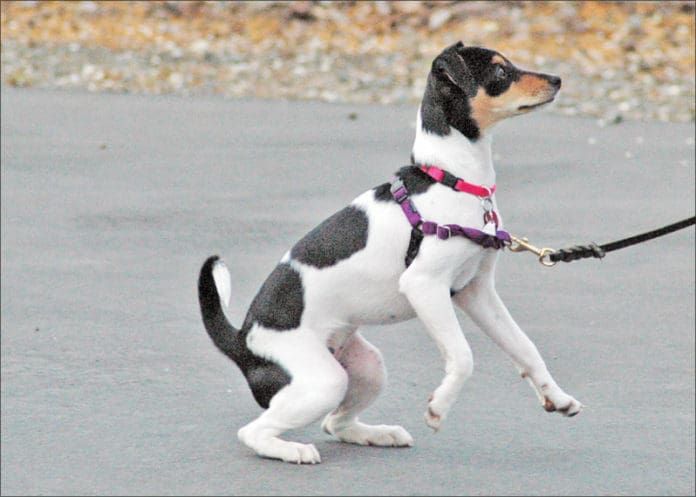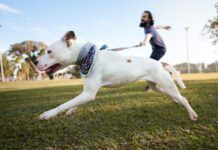[Updated November 15, 2017]
Recently, WDJ received a letter from Christine Zink, DVM, PhD, DACVP, DACVSMR, who was concerned about the photo in WDJ (on the cover, no less!) of a jogger whose dog, running alongside, was wearing a front-clip-type harness. A sports medicine guru and canine athlete enthusiast, Dr. Zink (and others) posit that no-pull harnesses are detrimental to a dog’s structure and gait – and are especially inappropriate for canine athletes.

In a limited gait analysis study, Dr. Zink observed that dogs wearing no-pull, front clip harnesses bore less weight on their front legs than they normally would – even when the harness wasn’t attached to a leash! In addition, the dogs bore less weight on the leg that was on the far side of where the person walked, even when there was no leash attached; when the dog had a leash attached, it was more significant. This suggests to her that the dog was reacting to the presence of the harness against the leg by pushing harder against it. In all cases, the gait of the front limbs was altered whenever the harness was on.
Dr. Zink explains that these harnesses sit on top of the biceps and supraspinatus tendons, two of the most commonly injured structures in dogs’ forelimbs, particularly in canine athletes. She asserts that, just by logic, one has to assume that the pressure this kind of harness exerts on the dog’s forelimbs in an activity where the dog is supposed to be extending her forelimbs (i.e., running, walking), is not a good idea.
“I do not believe that there is a harness on the market that is nonrestrictive and that also helps the dog not to pull,” says Dr. Zink.” There are however some very nice, well constructed, nonrestrictive harnesses on the market. However, those should not be considered as a method to teach a dog not to pull. In my opinion the real way to get a dog to stop pulling is to train it.”
Taking another position altogether are the thousands of dog trainers and behaviorists who contend that no-pull harnesses save lives, because by giving handlers a mechanical advantage over the dog, they help people who have been unable to train their dogs (for whatever reasons) to walk politely, to walk their dogs anyway.

Whole Dog Journal Training Editor Pat Miller, CBCC-KA, CPDT-KA, comments, “I am a dog trainer/behavior professional with a very specialized concern about helping dogs be well-mannered companions to their humans. I agree that the way to get a dog to stop pulling is to train it. No-pull harnesses provide, in my experience, the least harmful way to give many owners the window of opportunity to reinforce -and thereby train – polite leash walking. An owner can’t train a dog to walk on leash if she is getting dragged off her feet. I will continue to use front-clip harnesses and recommend them to clients, at least until someone comes up with an even safer non-aversive alternative.”
Like so many of our equipment choices, there are cases for and against using a front-clip or other no-pull harness. Each of us must consider the benefits and risks, and make an educated decision based on what is best for us and our own dogs.







Reading Whole Dog Journal to see what I can do to keep my Jack-whippet girl from pulling me off my feet when she sees a human neighborhood friend or one of their dogs. I am 78 years old and just had an incident when we were coming down one neighbor’s front steps and she saw another neighbor-friend, who she lept forward to see. I fell forward and currently have a sore neck, arms, back, and new “floaters” in my eyes.
I have taken her to a trainer, who she performed for flawlessly. He even did an exercise with a large stuffed dog toy to try to get her to ignore it. She did. Not so with live dogs, who I think she wants to play with. However I have had enough instances where she has pulled me off my feet totally, that I am afraid to have any “play dates” with even the more laid back canines. Let me be clear – under no circumstances am I taking her back to the animal shelter where I got her last fall !!!!!!!!!!!!!! I love her and she loves me!!!!!!!!!!!!!!
I currently have a Kumro harness on her. Tried a head harness, but was always getting it on wrong all the time. Currently I attach her martingale collar to the back ring of the Kumro and thread the leash through the sturdy hand loop on the back. My left arm is getting much stronger, so I am usually able to hang on to the leash. I am using the command “no pull” and giving the leash a quick jerk when she is in danger of picking up momentum. I have to be careful not to let anyone along the way play “koochi-coo” with her, because she wants to dance up to them. (She loves everyone & I have had to train her not to rear up and place her front paws on their chest so she can lick their chins). If a human approaches us to talk, I lean against one of the parked cars to give me some support while I am exerting pressure on her leash. What other suggestions would you please give me that I could use in the Covid-19 environment?
I am sorry to hear your trainer was unable to help you with the pulling. I am just reading your comment today. Were you able to get your dog to be more calm? I’d love to hear how things are going.
What about a normal harness that clips in the back? I have owned pit bulls all my life and they pull on the leash, they’re luckily trainable but the biggest thing about leash walking is control. Pit bulls can be frankly, bullies and controlling an alpha dog that may outweigh you requires good training habits for you and the dog but also proper gear. That being said, can you please explain how a front clip style harness is superior to one that clips on the dogs back. I don’t understand the reasoning, it can’t be control, it sure isn’t for the comfort of the dog, so I am just confused by your choice if it’s just your preference, fine but if you have a professional opinion that this type is better please clue me in. Thank you for a great article.
I apologize for my previous comment, I WAS confused. I didn’t exactly understand how a ‘no pull’ harness worked but have since been educated. I can see what the experts mean about how it would affect their gait, I wouldn’t use one if these, training is a much better alternative. As Caesar Milan will tell you, most if the time its the owners that need the training. In the search for an easier way we selfishly risk our pets health. Well, thanks again for the article.
The vet is correct. The trainer is regurgitating harness propaganda. Both are correct in that training dogs to walk calmly on a loose leash is the solution. Harnesses are merely a management tool and a marketing fad for those looking for a quick fix. Halters that torque the head sideways are worse. These can result in neck injuries to the dog. For those that are biased in favor of a head harness, a better tool is the K-9 Bridle. Personally I have found no better tool to train a dog to walk calmly on a loose leash than a prong collar that is fitted and sized properly and used as intended, or alternatively a Starmark Pro training collar. I realize that I will likely get more than a few frowny faces or hate comments for being honest in this context. However. I deal with rescue dogs that were saved from being put down at shelters for little more than merely chronic leash pulling and general lack of obedience. If there are any magic tools available that makes helping dogs with leash pulling issues easier, safer and more effective then I would enthusiastically adopt them. I have tried the harnesses, halters and others and these have turned out to be merely marketing gimmicks.
What happens if you NEED a quick fix because your older puppy came from another home and didn’t get proper training before? Our puppy had never been taken for a walk before we took her in. She gets too distracted and we need to rein her in TEMPORARILY so we can get her to a place where she focuses on us and has good recall.
You have no control using a harness. Use a properly fitting collar, snug it high under the dogs chin and walk with a taut lead until the dog knows and learns what you expect when you’re walking and develops manners. You’re the human in charge, do it with kindness but firmness. Dogs need to know what you want them to do. Untrained dogs are usually just confused from mixed signals from you!
Why not give a link to Zink’s letter?
Thanks for the condescending article. I’ve been trying to research what to use on my dog to make her comfortable, happy and in good health. Articles like this don’t have the effect I think you think the do and I will not be using your articles in the future to educate myself. Training dogs can be hard, I have a great dog who is about to turn one and is smart and extremely stubborn. I’d say she is pretty well trained but not exactly where I want her to be yet, but we are working on it. Thankfully I know that you need to keep at it, and keep reinforcing what has already been learned. Not everyone realizes this and needs kindness and motivation.